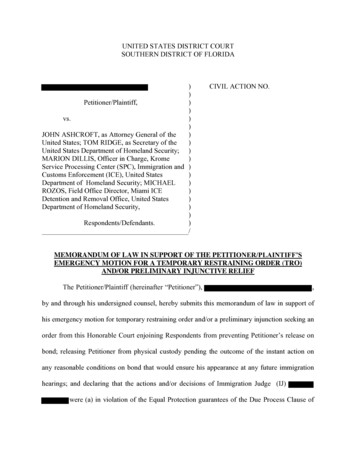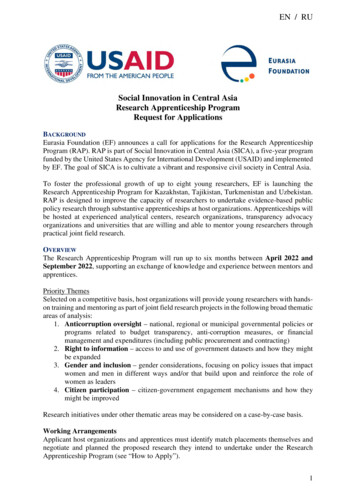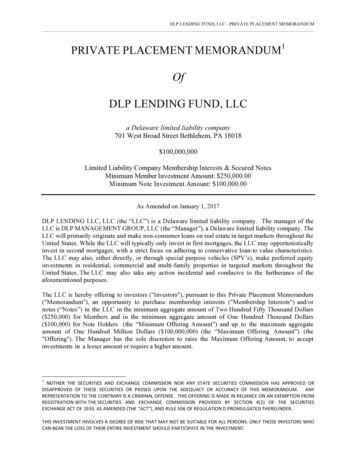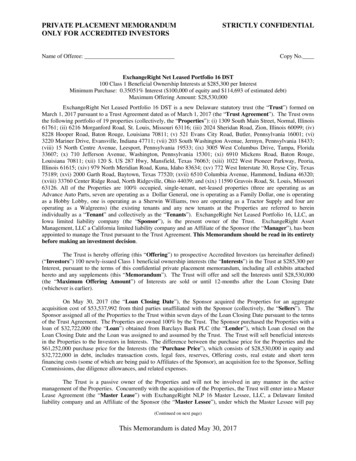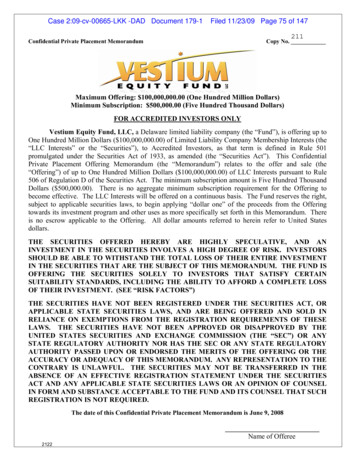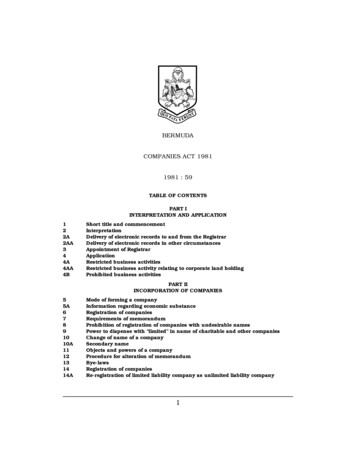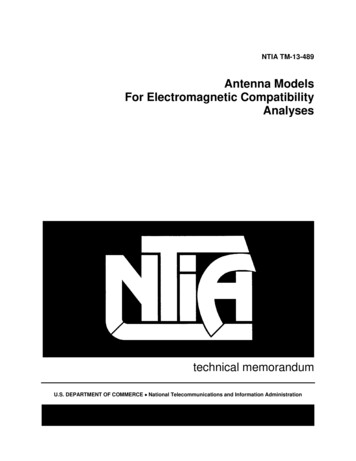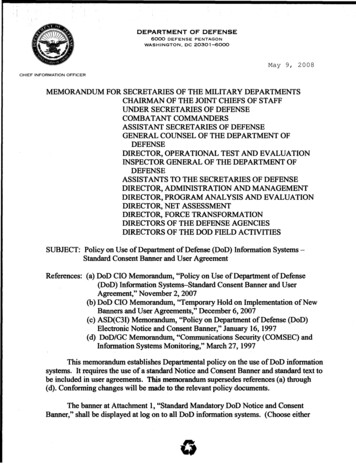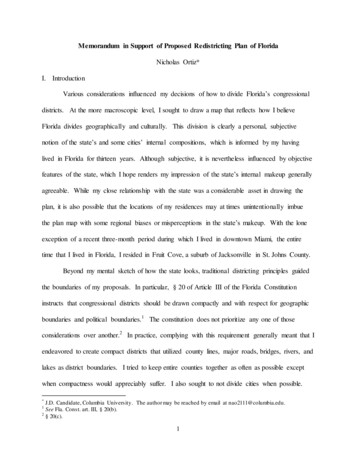
Transcription
Memorandum in Support of Proposed Redistricting Plan of FloridaNicholas Ortiz*I. IntroductionVarious considerations influenced my decisions of how to divide Florida’s congressionaldistricts. At the more macroscopic level, I sought to draw a map that reflects how I believeFlorida divides geographically and culturally. This division is clearly a personal, subjectivenotion of the state’s and some cities’ internal compositions, which is informed by my havinglived in Florida for thirteen years. Although subjective, it is nevertheless influenced by objectivefeatures of the state, which I hope renders my impression of the state’s internal makeup generallyagreeable. While my close relationship with the state was a considerable asset in drawing theplan, it is also possible that the locations of my residences may at times unintentionally imbuethe plan map with some regional biases or misperceptions in the state’s makeup. With the loneexception of a recent three-month period during which I lived in downtown Miami, the entiretime that I lived in Florida, I resided in Fruit Cove, a suburb of Jacksonville in St. Johns County.Beyond my mental sketch of how the state looks, traditional districting principles guidedthe boundaries of my proposals. In particular, § 20 of Article III of the Florida Constitutioninstructs that congressional districts should be drawn compactly and with respect for geographicboundaries and political boundaries.1 The constitution does not prioritize any one of thoseconsiderations over another.2 In practice, complying with this requirement generally meant that Iendeavored to create compact districts that utilized county lines, major roads, bridges, rivers, andlakes as district boundaries. I tried to keep entire counties together as often as possible exceptwhen compactness would appreciably suffer. I also sought to not divide cities when possible.*J.D. Candidate, Columbia University. The author may be reached by email at nao2111@columbia.edu.See Fla. Const. art. III, § 20(b).2§ 20(c).11
As § 20 indicates that a redistricting plan should not prioritize political boundaries overotherwise preferable geographic boundaries, the proposed plan is not precisely a “goodgovernment” plan that emphasizes compactness and respect for political subdivision lines.Hence, I have described it as a “portfolio” plan.Florida’s constitution contains an additional requirement that “[n]o apportionment plan orindividual district shall be drawn with the intent to favor or disfavor a political party or anincumbent . . . .”3 I did not utilize political data in constructing my proposed districts. Exceptwhen relevant to determining the plan’s compliance with the Voting Rights Act (“VRA”) or theFlorida Constitution, I did not predict or otherwise consider the voting tendencies of theelectorate in different areas. I do not know the political consequences of my proposals, and eventhe guesswork in which I occasionally need to engage I fully acknowledge may be whollyinaccurate. I also did not consider the location of the residence of any incumbent. Additionally,I largely disregarded the existing district lines in constructing my proposed districts, asrespecting existing lines for no reason other than that they preceded this proposal woulduselessly increase the advantages of incumbency. However, the proposed districts do notactively seek to depart from existing district lines, except to the extent that existing district linesdepart from neutral districting principles. Indeed, several proposed districts overlay very closelywith existing district lines, although the reasons for such results are apolitical. Similarlyconstructed districts resulted from an effort to comply with the Voting Rights Act (“VRA”), theFlorida Constitution, or traditional districting principles.Florida gained two congressional districts after the most recent census. The state nowhas 27 congressional seats allocated to it. I should note that I did not seek to “add” the newdistricts in any particular part of the state for two reasons. First, I did not seek to benefit any3§ 20(a).2
portion of the state at the expense of any other in constructing this plan. I do not believe any partof the state is more deserving of an additional district or two than any other part, unlessdemographics so dictate. Second, the notion that one who makes a redistricting plan hasdiscretion where to add a district or two seems to misunderstand the principle that congressionaldistricts must be equipopulous. Congressional districts surround wherever the state’s populationis located. The demographic trends of the state determine where districts are “added.” If onecity in Florida previously had a population of 1/27 of the state, but since 2000 its population hasgrown to 3/27 of the state, that city would necessarily contain at least three districts under thenew plan, whereas it previously only needed to include one district. 4 New districts “should,” anddo, go wherever the population is.5 That is the premise and consequence of the Equal ProtectionClause’s requirement of “one person, one vote.” As such, accommodating two new districts didnot create any problems in crafting this redistricting plan.Florida’s current congressional map as a whole and many of Florida’s currentcongressional districts are commonly regarded as diverging strongly from traditional districtingprinciples in order to advantage the Republican Party.6 This perception may have motivated the4Or, viewed differently, suppose Florida had had only one congressional district under the current plan and it nowmerits two congressional districts. If Florida then is divided in half to accommodate the new district, where has thenew district been added?5Obviously the borders of the districts are malleable, but to the extent one considers the adding of a district toinclude creating an additional jutting appendage into an area, then one could presumably create as many as 27districts throughout the state. But as districts must be compact, this is an impermissible way to “add” a district. Inany event, the creation of new jutting appendages does not appear to be what most mean when they speak of addinga newly received district in some part of the state as opposed to another. Indeed, that could be done irrespective ofwhether the state had gained an additional district or two.6See, e.g., Fred Grimm, Governor Has No Problem Ignoring Will of Voters, M IAMI HERALD, Jan. 21, 2011(“[B]latant gerrymandering . . . has long characterized the state’s legislative and congressional districts.”), availableat http://www.miamiherald.co ing.ht ml#ixzz1KnHGvKfn;Leon W. Russell & J. Gerald Heber, Put an End to Gerrymandering in Florida, ST . PET ERSBURG TIMES, Aug. 10,2010 (“Florida has fewer competitive elections than almost any state in the union .”), available nd-to-gerrymandering-in-florida/1114190; Editorial, One-SidedRaces, ORLANDO SENT INEL , July 30, 2004 (opining that the majority-Republican legislature successfully packedDemocrats into as few districts as possible leading to the result that only one of Florida’s 25 congressional districtsunder the current map is “truly competitive”), available at /0407300044 1 gerry mandering-districts-in-florida-lawmakers.3
successful ballot initiative to amend the Florida Constitution during the 2010 congressionalelections, which resulted in the addition of Sections 20 and 21 to Article III of the stateconstitution. Section 21 mirrors Section 20’s requirements but applies to the process ofreapportioning state legislative districts.Although there is indeed significant overlap in several districts under the current andproposed plans, as others have opined, many districts under the existing plan fare poorly underneutral districting principles. For example, the current congressional District 11 divides St.Petersburg by carving out the tip of the St. Petersburg peninsula, which has a predominantly nonHispanic black (hereinafter “black”) population.7 In doing so, the district crosses Tampa Bay inorder to divide Pinellas County, the city of St. Petersburg, and the St. Petersburg peninsula. Byreaching into St. Petersburg, the district sacrifices compactness. As the district is not compactand disrespects major political and geographic boundaries, it violates all three principlescommanded by the new redistricting amendments. The district does not appear to have beencrafted to comply with the VRA or another state law.8 Rather it seems that the purpose behindgrabbing the St. Petersburg population was to create a safe Democratic district from heavilyDemocratic populations in Tampa and St. Petersburg.9 The plan I propose keeps the peninsulaand St. Petersburg undivided; it divides Pinellas County only once in order to meet therequirements of population equality.107See Figure 1 of Appendix.One justification may have been to create a black and Hispanic coalition district. This explanation isunderwhelming, however. Their unified electoral strength is more aptly described as perhaps a combined influencedistrict. Blacks only represent 27.3% of CVAP and Hispanics only represent 21.3% of CVAP. Moreover, since2000, the representative from current District 11 appears to have been the white majority’s candidate of choice. Theaddition of the black population of St. Petersburg is most likely explained as being motivated by the goal of creatinga very safe Democratic district.9Of the five congressional elections from 2002-2010, the Democratic nominee won an uncontested election onceand four elections with a total vote share of 85.82, 69.65, 71.66, and 59.64.10See Figure 2 of Appendix.84
II. Legal ComplianceThree sources of law imposed significant constraints on this redistricting plan. They arethe United States Constitution, the Voting Rights Act, and the Florida Constitution. Theproposed redistricting plan complies with the obligations and restraints imposed by those laws.A. Federal Constitutional Requirements1. One Person, One VoteThe Equal Protection Clause of the 14th Amendment to the United States Constitutionrequires that congressional districts contain populations that are as close to perfect equality “as ispracticable.”11 Although the Supreme Court has noted that the relevant population figure that aplan seeks to equalize need not be total population, 12 uncertainty remains nationally as to whatalternative population variables may be used to evaluate a plan’s compliance with the “oneperson, one vote” principle.13 The Eleventh Circuit has not addressed the issue. Accordingly,this proposal equalizes total population figures, which the Court has approved as a valid measureof population equality.14The U.S. Census Bureau reported Florida’s total population in 2010 at 18,801,310persons. That population warrants 27 congressional districts. The ideal district size is696,344.81. To achieve the least deviation as is possible from perfect population equality, 22districts must contain 696,345 persons and five districts must contain 696,344. The proposedplan distributes Florida’s population in that manner.11Karcher v. Daggett, 462 U.S. 725, 730 (1983).See Burns v. Richardson, 384 U.S. 73, 91-92 (1966).13Compare Garza v. County of Los Angeles, 918 F.2d 763 (9th Cir. 1990) (concluding that citizens of voting agepopulation is not a proper standard for population equality), with Daly v. Hunt, 93 F.3d 1212, 1227-28 (4th Cir.1996) (permitting the political branches to decide which measure of population to equalize), and Chen v. City ofHouston, 206 F.3d 502, 523 (5th Cir. 2000) (same). Accord Chen v. City of Houston, 532 U.S. 1046, 1046 (2001)(Thomas, J., dissenting) (dissenting from denial of petition for writ of certiorari because “as long as we sustain theone-person, one-vote principle, we have an obligation to explain to states and localities what it actually means.”)14See, e.g., Burns, 384 U.S. at 91.125
2. Racial GerrymanderingThe Equal Protection Clause also prohibits congressional districts that include unjustifiedracial gerrymandering. If considerations of race predominate in the drawing of a district,subordinating traditional districting principles, strict scrutiny analysis applies and the district willnot be upheld as valid unless it is narrowly tailored to satisfy a compelling state interest.15Where this redistricting plan deviates from traditional districting principles, it does so bynarrowly tailoring districts that further the state’s compelling interests of compliance with theVRA and the Florida Constitution.a. The State’s InterestAt least two of the proposed districts subordinate traditional districting principles in orderto comply with §§ 2 and 5 of the VRA and Article III of the Florida Constitution, which has anon-retrogression requirement that parallels that of § 5 of the VRA.16 In Section II.B below Iargue that compliance with § 2 compels the drawing of each of the majority- minority districts. If§ 2 of the VRA does not require one or more of the districts, Article III of the FloridaConstitution would require them to prevent retrogression.Although the Court has never held so in any case, a majority of the current justices haveagreed that compliance with §§ 2 and 5 of the VRA is a compelling state interest.17 Therefore,racial gerrymandering to comply with §§ 2 or 5 of the VRA appears permissible so long as it isnarrowly tailored.Whether compliance with Article III supplies a compelling state interest is uncertain,although there are good reasons to believe that it does. By amending Article III of its15See Miller v. Johnson, 515 U.S. 900, 916 (1995); Shaw v. Reno, 509 U.S. 630 (1993).Section 5 of the VRA applies only to certain counties of Florida. Only Collier, Hardee, Hillsborough, Hendry,and Monroe Counties are subject to § 5. See Section 5 Covered Jurisdictions, U.S. DEP ’T OF JUST ICE (last visitedApr. 30, 2011), http://www.justice.gov/crt/about/vot/sec 5/covered.php.17See League of United Latin Am. Citizens v. Perry, 548 U.S. 399, 518-19 (2006) (Scalia, J., dissenting); Bush v.Vera, 517 U.S. 952, 976-77 (1996) (plurality opinion).166
constitution to add § 20(a), Florida imposed on the entire state the anti-retrogression redistrictingrequirements with which jurisdictions covered by § 5 of the VRA must comply. The Courtbelieves § 5 of the VRA offers a compelling purpose18 even though the Court has doubted theutility of the triggering mechanism.19 Indeed, the problematic aspect of § 5 to these justices isthat the triggering mechanism both is imprecise and represents a potential affront to statedignity.20 Therefore, the Court has determined that the VRA offers a compelling purpose despiteits triggering mechanism’s imprecision and imposition on state sovereignty. As such, when astate voluntarily decides that it should protect racial or language minorities’ ability to participatein the political process in the same manner prescribed by § 5 of the VRA, presumably the Courtwould regard the state’s interest in such a circumstance at least as compelling as when Congressdirects that the state act in such a manner.Indeed, a refusal to recognize the state’s interest in complying with a successful ballotinitiative substantially similar to § 5 would arguably itself represent an affront to Florida’simportant sovereign interests. The citizens of Florida voted to amend Article III to include § 20presumably because they believed it would improve the state’s democratic functioning byincreasing the ability of minorities to participate in the political process. Therefore, adetermination that compliance with Article III does not represent a compelling state interestwould be inconsistent with Court precedents respecting both the compelling value of the VRA’spurpose and of states’ interests in self-governance.2118See League of United Latin Am. Citizens v. Perry, 548 U.S. 399, 518-19 (2006) (Scalia, J., dissenting); Bush v.Vera, 517 U.S. 952, 976-77 (1996) (plurality opinion).19See N.W. Austin Util. District Number One v. Holder, 129 S. Ct. 2504, 2511-12 (2009); id. (Thomas, J.,concurring in part and dissenting in part).20Id.21In any event, if § 2 requires the districts, as I argue it does, whether compliance with Article III offers acompelling state interest to justify narrowly tailored racial gerrymandering would be a moot question.7
b. TailoringIn an effort to narrowly tailor the districts to the requisites of the VRA and § 20(a), Isought to make the majority-minority districts as compact as practicable and to increase theextent to which the districts’ borders relied on existing political or geographic boundaries.Florida’s current District 23, for example, contained four appendages reaching from the state’sinterior to pockets of black populations in Fort Pierce, West Palm Beach, Fort Lauderdale, andMiramar.22 The distance from Miramar to Fort Pierce spans approximately 120 miles. I wasable to craft a majority black district that eliminates the outermost appendages of current District23 and which spans instead from West Palm Beach to Fort Lauderdale, a distance ofapproximately 50 miles.23 This proposed district, District 9, also captures a heavily blackpopulation in Belle Glade, in the western half of Palm Beach County, as the current District 23does. I also substantially improved the compactness of the other majority- minority districts inSouth Florida.24Meanwhile, where increasing the compactness of certain other majority- minority districtswas particularly difficult I sought to improve the districts’ adherence to other traditionaldistricting principles. In order to create a district whose citizens of voting age population(“CVAP”) are a majority black in the northern half of Florida, a district must stretch fromJacksonville to Gainesville to Orlando, a stretch of approximately 180 miles. Current District 3captures these populations.25 Although increasing that district’s compactness was nearly ahopeless endeavor, I was able to improve the district’s adherence to traditional districtingprinciples by at least having its eastern border perfectly follow the St. Johns River from22See Figure 3 of Appendix.See Figure 4 of Appendix.24See discussion infra Section III.A.25See Figure 6 of Appendix.238
Jacksonville to Orlando.26 As the St. Johns River also functions as a border between counties tothe east and west of it, aligning the proposed district, District 26, along the river also improvedthe district’s respect for existing political boundaries. Current District 3 does not follow the St.Johns River exactly. It reaches back and forth over the river to grab substantial portions ofPutnam County, and abandons the river as a border entirely in Volusia County.I also endeavored to improve the tailoring of proposed District 26 by seeking to create analternative district incorporating most of the black population of current District 3 that wouldbetter adhere to traditional districting principles. The alternative I sought to create stretchedalong Florida’s northern border from Jacksonville to Tallahassee. Such a district would haveimproved the district’s cultural compactness, as the northern portion of the state is typicallyregarded as featuring a distinctively Southern culture. Orlando is somewhat of the crossroads ofthe state, where the Southern elements of Florida begin to mix with the state’s Hispanicinfluence, more characteristic of South Florida. Orlando is also well known for its populartourist attractions, which are less numerous and significant in North Florida. Nevertheless, Icould not create such a district with a majority black VAP or CVAP. The highest CVAPpercentage I could create with such a district was approximately 47%. The current District 3 hasa CVAP of 50.8%. Additionally, the district I sought to create would have had to suffermarkedly in compactness and in its respect for political and geographic boundaries. The districtwould have had to feature many southwardly extending appendages that would have made itmuch more of an eyesore than even the current District 3. Indeed, to the extent appearances arerelevant, this would-be district would have had an almost haunting look, ominously reachingtowards the rest of the state. The compactness of several neighboring districts would havesuffered considerably as a result as well.26See Figure 5 of Appendix.9
Lastly, I considered as an alternative to proposed District 26 creating a coalition districtin and around Orlando of blacks and Hispanics. Puerto Ricans comprise a majority of CentralFlorida’s Hispanic population.27 Cubans represent only 7 percent of the Hispanic population inCentral Florida.28Unlike Cubans, who vote mostly Republican, 29 Central Florida’s PuertoRican population votes heavily Democratic, voting for Vice President Al Gore and Senator JohnKerry in the 2000 and 2004 elections at a rate of 60% and 66%, respectively. 30 Therefore, whileit would be inappropriate to seek to join blacks and Cubans into a coalition district, it arguablywould not be inappropriate to join blacks and Puerto Ricans into a coalition district.31 Becauseof the apparent substantial similarity in voting patterns of Central Florida’s black and and PuertoRican population, a coalition district could have been created here. The would-be coalitiondistrict would have been approximately 40% Hispanic CVAP and 20% black CVAP.If I had created that Central Florida coalition district, I would have also likely created ablack opportunity district of between 45 and 47% black CVAP running from Jacksonville toGainesville to Tallahassee. The Hispanic CVAP of that hypothetical district would have beenbetween 2 and 4%. One possible shortcoming I perceived in a Jacksonville-to-Tallahaseeopportunity district is the frequency with which it would have “performed ” to elect therepresentative of choice of the black voters. Assuming racial polarization in voting, the majoritynon-black voters in the district would vote predominantly Republican, or else otherwise for a27JORGE DUANY & FÉLIX V. M AT OS-RODRÍGUEZ , CENT RO DE EST UDIOS PUERT ORRIQUEÑOS AT THE CITY UNIV. OFN.Y., PUERT O RICANS IN ORLANDO AND CENT RAL FLORIDA, POLICY REPORT NO. 1 (2006), available athttp://www.centropr.org/documents/working papers/FloridaBrief(F).pdf.28Maria T. Padilla, Puerto Ricans Stream Into Area, ORLANDO SENT INEL, Mar. 24, 2011, available ews/0105240302 1 ricans -central-florida-hispanics/2. CentralFlorida’s remaining Hispanic population is of Mexican, Central American, and South American origin. Id.29DUANY & M AT OS-RODRÍGUEZ , supra note 23, at 22.30Id. at 4.31Under the Eleventh Circuit’s § 2 jurisprudence predating Bartlett v. Strickland, 129 S. Ct. 1231 (2009), discussedinfra Part II.B.1, a state may create a cross-over or coalitional district pursuant to § 2. See Concerned Citizens ofHardee County v. Hardee County Bd. of Comm’rs , 906 F.2d 524, 526 (11th Cir. 1990) (“Two minority groups (inthis case blacks and hispanics) may be a single section 2 minority if they can establish that they behave in apolitically cohesive manner.”).10
candidate other than that preferred by the black population. Indeed, all of North Florida’scurrent congressional districts, with the exception of District 3, are occupied by a Republicanrepresentative. All of the districts currently held by Republicans appear to be safely Republican;only current District 2, one of the districts embracing Tallahassee, has been held by a Democratthis past decade.One consideration counseling in favor of creating the coalition and opportunity districts isthe fact that Florida’s VAP is approximately 21.1% Hispanic, although under my proposed plan,only three of the state’s 27 districts (11.1%) would be majority Hispanic. Moreover, thosedistricts that are majority-Hispanic are all located in South Florida, where the Cuban-Americanpopulation predominates over other Hispanic populations. However, Cubans consist of only36% of Florida’s Hispanics of VAP, or 7.6% of the state’s total population.32 Therefore, withthree majority-Hispanic districts in South Florida and none elsewhere, Florida’s Cubanpopulation, which votes dissimilarly from the state’s non-Cuban Hispanic population,33 isdisproportionately overrepresented with 11.1% of the state’s representatives. The remainder ofthe state’s non-Cuban Hispanic VAP—nearly as numerous at 13.5% of VAP as the state’s nonHispanic black population, which is 13.7% of VAP—would lack a single district that wouldlikely elect the representative of the group’s choice.Nevertheless, I chose to retain the Jacksonville-to-Orlando majority black district becauseI sought to avoid undoing a safely performing black district,34 which would have renderedFlorida’s black population disproportionately underrepresented if the Jacksonville-to-Tallahasseedistrict did not perform. I feared running afoul of Article III’s proscription against redistricting32PEW HISPANIC CENT ER, THE HISPANIC ELECT ORATE IN FLORIDA (2004), available DUANY & M AT OS-RODRÍGUEZ , supra note 23, at 22.34Current District 3 is held by Democrat Corrine Brown. In the past five elections Brown has won three timeswithout opposition by a Republican candidate and with 63.0% and 59.3% of the votes cast in the 2010 and 2002elections, respectively.11
plans that “diminish the[] ability [of racial minorities] to elect representatives of their choice.”Exchanging a safe black district in favor of a likely-Hispanic district and a black opportunitydistrict would probably be viewed as a retrogressive tradeoff as to the black population thatdiminishes the ability of blacks in Central and North Florida to elect representatives of theirchoice.In each majority- minority district, I sought to create the most compact district possiblethat accorded significant respect for political and geographic boundaries. I considered manyalternative schemes to those that I ultimately proposed. The proposed majority- minority districtsare the districts that I believe best adhere to traditional districting principles while complyingwith the VRA and Article III of Florida’s Constitution. Accordingly, the districts are narrowlytailored to the state’s compelling interest of complying with the VRA and the state constitution.I argue in Part II.B-C that the VRA and Florida’s Constitution require the majority- minoritydistricts that I propose.B. Federal Statutory Requirements1. Voting Rights Act § 2Under § 2 of the VRA, a majority- minority district must be created when a minoritygroup is “sufficiently large and geographically compact to constitute a majority” in a singlemember district, the minority group is “politically cohesive,” and the white majority votes“sufficiently as a bloc to enable it . . . usually to defeat the minority’s preferred candidate.”35The requirement that minority populations be sufficiently compact includes a requirement thatthe populations be culturally compact.363536Thornburg v. Gingles, 478 U.S. 30, 50 (1986).See League of United Latin Am. Citizens v. Perry, 548 U.S. 399 (2006).12
Additionally, it must be the case that under the “totality of circumstances,” minorities areless able to participate in the political process than the white majority.37 A plan will be valid,therefore, that tends to “thwart the historical tendency to exclude [minorities], not expand orperpetuate it.”38 One particularly significant factor in evaluating this last prerequisite is theproportionality of a minority group’s VAP relative to its percentage share of the districts inwhich it represents a majority of the VAP. 39 Section 2 does not require that a state create themaximum quantity of the majority-minority districts possible, particularly when proportionalityhas been achieved.40 Nevertheless, proportionality does not operate as a “safe harbor,” blessingall redistricting plans that achieve proportionality; it is merely relevant to the totality of thecircumstances inquiry.41Furthermore, § 2 does not require the creation of coalition or cross-over districts.42Section 2 only requires the drawing of districts when a single minority group constitutes morethan 50 percent of the VAP.43 Under Eleventh Circuit jurisprudence predating Bartlett, a statemay create a cross-over or coalitional district pursuant to § 2.44The proposed plan complies with § 2. Although I did not have the necessary politicaldata available at my disposal, I operate under the factual premises accepted by the SupremeCourt in Johnson v. De Grandy45 that South Florida’s black and Cuban-American populationsare separately politically cohesive and that the white majority votes sufficiently as a bloc to37Johnson v. De Grandy, 512 U.S. 997, 1011-12 (1994).Id. at 1014.39Id.40Id.41Id. at 1019-2042Bartlett v. Strickland, 129 S. Ct. 1231, 1245 (2009).43Id.44Concerned Citizens of Hardee County v. Hardee County Bd. of Comm’rs , 906 F.2d 524, 526 (11th Cir. 1990)(“Two minority groups (in this case blacks and hispanics) may be a single section 2 minority if they can establishthat they behave in a politically cohesive manner.”).45512 U.S. 997 (1994).3813
typically defeat the preferred candidates of both groups.46 This analysis, therefore, presumes thatthe second and third Gingles prongs are satisfied as to the black and Hispanic populations ofSouth Florida.This analysis also assumes that the black populations in North and Central Florida arepolitically cohesive and that the white majority votes sufficiently as a bloc to usually defeat theircandidates of choice. This project lacks the necessary political data to analyze those issuessufficiently, but those assumptions seem appropriate.The preponderance of the black population in the greater Miami metropolitan area islocated north of downtown Miami to the west of US-1 in a triangu
persons. That population warrants 27 congressional districts. The ideal district size is districts must contain 696,345 persons and five districts must contain 696,344. The proposed plan distributes Florida's population in that manner. 11 Karcher v. Daggett, 462 U.S. 725, 730 (1983). 12 See Burns v. Richardson, 384 U.S. 73, 91-92 (1966).
